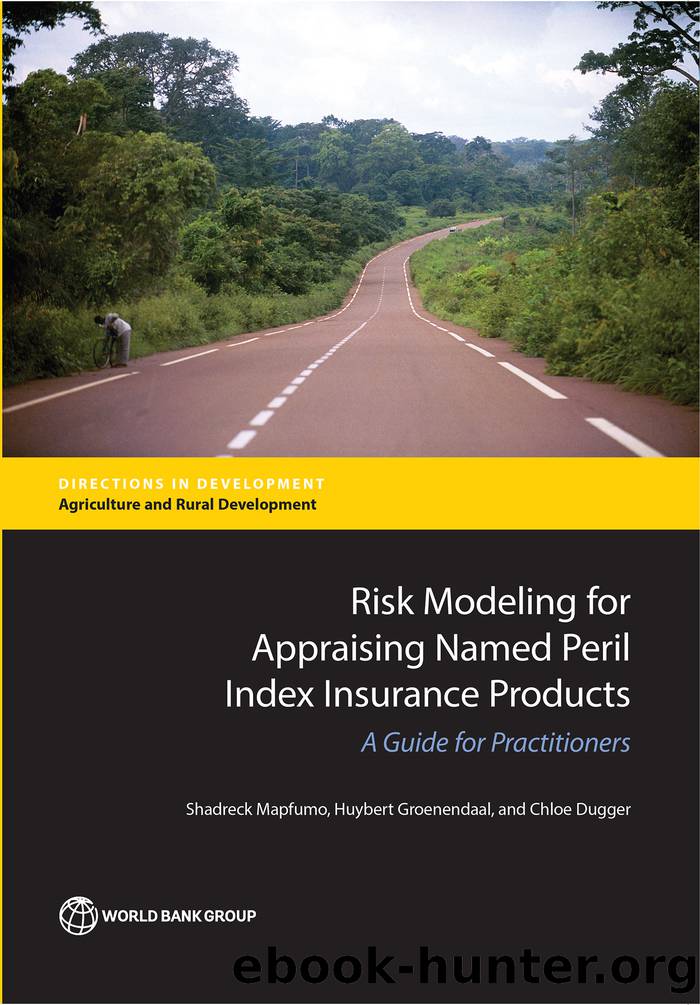Risk Modeling for Appraising Named Peril Index Insurance Products: A Guide for Practitioners by Shadreck Mapfumo Huybert Groenendaal & Chloe Dugger

Author:Shadreck Mapfumo, Huybert Groenendaal & Chloe Dugger
Language: eng
Format: epub
Turning to index insurance applications, suppose that we are again modeling insurer basis risk events, that is, situations in which the index product provides a payout despite there being no inventory damage attributable to the named peril. We have 10 years of historical data (n) and during those 10 years, an insurer basis risk event occurred in one year (s). A simple, first estimate of the probability of an insurer basis risk event is 10 percent (s/n). However, given our limited data set, we represent the uncertainty about the true probability as a beta distribution with alpha = 2 (that is, s + 1 = 2) and beta = 10 (that is, n â s + 1 = 10). If we do not use the beta distribution we ignore the uncertainty in the probability and can underestimate the overall risk.
10.2.1.2.4.2 Use of the Beta Distribution #2: Modeling continuous variables ranging from 0 to 1. The second potential use of the beta distribution is for modeling a continuous variable that can only vary from 0 to a maximum of 1. An example is the payout (as a percentage of the insured amount) that an index insurance product may produce next year. In fact, several of the example models that come with this guide use the beta distribution to simulate the payout ratios for cases in which there is a payout greater than 0 percent. The technique for determining the input parameters of the beta distribution based on the historical payout ratio for specific index products, called fitting distributions to data, is covered in section 10.2.2.1.
10.2.1.2.5 Gamma Distribution. The gamma distribution is another continuous distribution, but this one is bounded on the left by 0 and positively skewed without a right bound, meaning the right tail extends far to the right. A common application of the gamma distribution is in modeling the rate of Poisson events per unit of exposure, or the time required for a specific number of Poisson-distributed events to occur. In the insurance industry the gamma distribution is used to represent potential payout amounts in currency terms, for example, $400, rather than as a percentage of the sum insured, for example, 35 percent. The left-side bound at 0 corresponds to modeling payouts because only positive payout amounts are sensible. The long right-side tail represents the general behavior that, although most payouts will be of smaller amounts, a small number of payouts may be extremely large. Gamma distributions can also be used to represent trigger values, for example, 44 millimeters of rain during a crop season, because many triggers such as rainfall and degree hours can only have positive values.
There are different parameterizations of the gamma distribution, meaning that it can be calculated from functions that take different input parameters. A common parameterization requires two parameters: shape and scale. These are denoted by the Greek letters alpha and beta, respectively. The alpha parameter drives the shape of the distribution while the beta parameter drives its spread (scale). In practice, the
Download
This site does not store any files on its server. We only index and link to content provided by other sites. Please contact the content providers to delete copyright contents if any and email us, we'll remove relevant links or contents immediately.
The Brazilian Economy since the Great Financial Crisis of 20072008 by Philip Arestis Carolina Troncoso Baltar & Daniela Magalhães Prates(118547)
International Integration of the Brazilian Economy by Elias C. Grivoyannis(88363)
The Art of Coaching by Elena Aguilar(52890)
Flexible Working by Dale Gemma;(23242)
How to Stop Living Paycheck to Paycheck by Avery Breyer(19621)
The Acquirer's Multiple: How the Billionaire Contrarians of Deep Value Beat the Market by Tobias Carlisle(12213)
Thinking, Fast and Slow by Kahneman Daniel(12023)
The Radium Girls by Kate Moore(11899)
The Art of Thinking Clearly by Rolf Dobelli(10175)
Hit Refresh by Satya Nadella(9015)
The Compound Effect by Darren Hardy(8786)
Tools of Titans by Timothy Ferriss(8186)
Atomic Habits: Tiny Changes, Remarkable Results by James Clear(8157)
Turbulence by E. J. Noyes(7920)
A Court of Wings and Ruin by Sarah J. Maas(7620)
Change Your Questions, Change Your Life by Marilee Adams(7610)
Nudge - Improving Decisions about Health, Wealth, and Happiness by Thaler Sunstein(7544)
How to Be a Bawse: A Guide to Conquering Life by Lilly Singh(7360)
Win Bigly by Scott Adams(7078)
